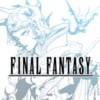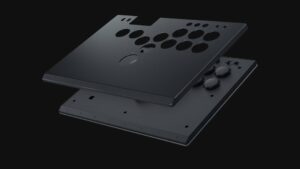![]() Ooh, he said the thing. No, my dearest of long-time readers, the RPG Reload isn’t making a regular comeback. But with Square Enix’s Final Fantasy Pixel Remaster series about to make the hop to consoles sometime in the next month or two, I thought it might be nice to look back on these games. The earliest of the bunch are almost two years old now, and they’ve all seen quite a few patches and bug fixes since release. I also wanted to have a sober look at the games, away from the initial glow of having shiny new versions of some of my favorite RPGs. So here we are, and there we shall go, game by game. Starting, of course, with…
Ooh, he said the thing. No, my dearest of long-time readers, the RPG Reload isn’t making a regular comeback. But with Square Enix’s Final Fantasy Pixel Remaster series about to make the hop to consoles sometime in the next month or two, I thought it might be nice to look back on these games. The earliest of the bunch are almost two years old now, and they’ve all seen quite a few patches and bug fixes since release. I also wanted to have a sober look at the games, away from the initial glow of having shiny new versions of some of my favorite RPGs. So here we are, and there we shall go, game by game. Starting, of course, with…
Final Fantasy ($11.99) – [Review]
This and the second game have seen so many remakes and rereleases over the years that it’s hard to sort out exactly which one got the most things right. Luckily, the basic framework of this initial adventure seems to be robust enough to shine under a variety of circumstances, and I at least can have a lot of fun with any version of it. The Pixel Remaster is a purer take in some ways, forcing the player to use the Vancian magic system and removing all of the extra content added in since Final Fantasy Advance started that particular ball rolling. With the hindsight of a couple of years, I still fully approve of the former decision while remaining mixed on the latter.
I think the game’s difficulty balance works better with the Vancian magic system, even with it being essentially just as easy as the previous version in almost every other regard. As for the removed content? It had a tendency to be very meta, with bosses drawn from later games in the series and no real narrative support for why all of that stuff was there. The extra content from the PSP version that also made its way into the mobile versions tried a bit harder to fix that aspect, and I rather liked how it was accessible from the Temple of Fiends. The story and world certainly make more sense without the extra dungeons and bosses, but they were a lot of fun and added a lot of value to an otherwise relatively short game.
This Pixel Remaster release didn’t have as many issues as some of the later ones, so it’s only had a few updates that fixed minor bugs and tweaked the UI a little. It’s not too different now than it was back at launch, but it didn’t need much work anyway. Sadly, the poor font remains in place. For better or worse, Square Enix seems to want to stand by it. We also still don’t have external controller support in any of these Pixel Remasters, which is another baffling decision on Square Enix’s part.
Is it better than the one we had before?
I love that new soundtrack and the classic-style pixel art, but the previous version we had was based on the PSP version, which itself had a nice soundtrack and a good visual style. I actually find myself missing that extra content, too. It’s a close call, but I’m going to go with a no on this one.
Final Fantasy II ($11.99) – [Review]
![]()
The series black sheep has never really shown its true fangs to the Western audience thanks to virtually every one of the localized remakes toning down its difficulty. The Pixel Remaster is a little more difficult than some of the previous reissues, but it’s still considerably less of a hassle than the original. Unlike with the Pixel Remaster of the first game, there are no major mechanical changes here from the previous reissue. It gets an overhaul to its presentation, cuts the content introduced in Dawn of Souls, and that’s about that. It has had even fewer updates than the first game, but one of those fixed a bug that ended up making the game a bit harder.
Is it better than the one we had before?
No, in this case I can certainly say it isn’t. The previous mobile version was based on the PSP version, so it looked and sounded pretty good. The cut content is the big issue here, as it added considerably to the game both narratively and in terms of things to do. It’s a lesser game without Soul of Rebirth, no question of it. None of the additions and improvements make up for its loss, and I’m not sure how they could.
Final Fantasy III ($17.99) – [Review]
![]()
This is where we get into some interesting differences with the Pixel Remaster series. Final Fantasy III historically had fewer remakes than the other 8-bit games, and when it finally got its first one it was a drastic change. The nameless Onion Kids were changed into named characters with personalities and individual back stories, and the gameplay systems were heavily altered for balance purposes and to accommodate the limitations of the Nintendo DS’s 3D capabilities. This Pixel Remaster is based on the original 8-bit version and follows it considerably more carefully than the 3D version. It fixes bugs, removes the limitations on the Job Class system, and tweaks some of the jobs for balance purposes.
It’s a really nice version that is more faithful to the original game than the 3D version, and that’s important because we’ve never had an official localized version of the original Final Fantasy III before. This one has also only had a few updates since it launched, but it didn’t have very many issues to deal with. As such, those updates were mainly to fix small unintended gameplay issues.
Is it better than the one we had before?
Considerably so, but if you don’t agree the previous version is still available to purchase and play. The 3D version is an interesting alternative take that is worth running through at least once, but the original version this Pixel Remaster is based on just hangs together better. Add in some lovely new visuals and arranged tunes and it’s a true winner.
Final Fantasy IV ($17.99) – [Review]
The series stepped to 16-bit with this installment, and this is where the series starts getting more complicated and bug-prone due to the implementation of the Active Time Battle system. Final Fantasy IV has been remade and rereleased more than any other game in the series, and it’s one of the few where most of those efforts have been solid. It’s also had a few fascinating forks, which makes this “back to basics" Pixel Remaster an interesting one. While it may initially seem to have rolled back to the Super Famicom original, it includes a number of elements from later versions.
The extra game content from the Advance version onward has been removed, and with it goes the party customization feature that allowed you to bring whoever you wanted with you into the late game areas. The result is a considerably polished take on the stock game, which I suppose is the objective of the Pixel Remaster series. For mobile fans, that’s a good thing. The existing mobile version of Final Fantasy IV, the 3D remake, makes a lot of changes in an effort to throw curveballs at long-time fans who had already played this game to death. As such, this is the first time an experience reflective of the original game has been available to mobile players.
This game came in very hot at launch, but has only had a couple of updates since. Those updates were almost entirely devoted to smashing bugs, but there were some small visual tweaks made as well. The game is generally stable and working as intended at this point, so I suppose those were well-aimed bug fixes.
Is it better than the one we had before?
I don’t consider the 3D remake of Final Fantasy IV to be representative of the original game but rather a fantastic complement to it. I do like the Pixel Remaster better of the two, but I’m awfully fond of that 3D version too. Play them back-to-back for maximum effect. Fortunately, the 3D version is still available so you can do just that.
Final Fantasy V ($17.99) – [Review]
One thing I will say about the Pixel Remasters of the 16-bit games is that the visual makeovers tend to be a bit more subtle. If the original games used half-sized sprites, so do the Pixel Remasters. Even with added colors, it’s hard to make those little fellows look a lot better than their 16-bit cousins. At any rate, this version of the game gives the presentation the makeover that all of them received, cuts out the extra content added in the Advance versions onward, and fixes some bugs from the original game. In terms of mechanics and balancing, it builds on the previous mobile version of the game and makes a few other tweaks on top of it. A solid version of a solid game that never really had many dramatic additions or changes in its rereleases, only losing some bonus dungeons and a few bonus jobs that weren’t really that interesting to begin with.
This version came in even hotter than Final Fantasy IV at launch, with a soft lock-up that happened very reliably against the final boss and one of the optional super bosses. The job system and the way things interact make this by far the most mechanically complicated of these six games, and there were some issues with all of that as well. It has had several updates since its release, and after a lot of work it seems to be in a properly functioning state.
Is it better than the one we had before?
This might be a controversial take, but I say that it isn’t. I love the new music and the consistent art style is certainly an overall improvement from the awkward mismatched assets in the previous mobile version. But I miss those big, expressive new sprites, and I certainly appreciated its stability. The extra content isn’t much, but I suppose I’d rather have it than not if I have the choice. Still, the gap isn’t dramatic here by any means and I could easily see someone preferring the more visually consistent look of the Pixel Remaster.
Final Fantasy VI ($17.99) – [Review]
Here is a game that has had a considerably less kind treatment with its rereleases and remakes. One of Square’s true masterpieces, one could say that the original was so near to perfect that it’s unsurprising any attempts to add to it only resulted in a worse experience. Like many of the other games, it got some new content added in its Game Boy Advance version, and as with the other Pixel Remasters it has been removed here. It was decent content but not really anything game-changing, so it’s not a massive loss. Mechanically and in terms of balance it builds on the previous mobile version, but fixes some bugs and makes additional tweaks.
The biggest change in this version comes with the famous opera scene. The warbles of the original music have been swapped out for a full vocal track, and the play itself is presented in Square Enix’s HD-2D format, the only time any of the Pixel Remasters dip into that style. It takes what was already one of the most memorable scenes of the series and makes it shine even brighter. Any fan of this game owes it to themselves to see this in action, and dare to dream of what a full-on remake of this all-timer could look like if Square Enix wanted to go all-in.
This was another one that had a lot of problems at launch and took a number of patches to get into proper shape. There were a lot of progression-blocking bugs that could occur, and Gau could cause all kinds of messes. Several updates later, it seems to largely be working as it should. Still no controller support or change to the font, but that’s the case for all of these Pixel Remasters.
Is it better than the one we had before?
Yes. While I thought the new sprites created for the previous mobile version had their charms, the grittier story of Final Fantasy VI works better with a grittier art style, to say nothing of the overall improvements to visual consistency. The new opera scene is an absolute barn-burner, and this is one soundtrack that demands to be heard in its arranged form. The only serious loss here is the controller support, and I will keep lighting a candle hoping Square Enix will add it to these games at some point.
So there we go. An abuse of the beloved RPG Reload brand? Possibly. An excuse for Shaun to write about Final Fantasy games again? Extremely likely. But it’s too late to go back now, so I hope you at least enjoyed this little look at Square Enix’s big make-good attempt for the first six installments of its landmark franchise. As always, thanks for reading!
- SEO Powered Content & PR Distribution. Get Amplified Today.
- Platoblockchain. Web3 Metaverse Intelligence. Knowledge Amplified. Access Here.
- Source: https://toucharcade.com/2023/03/29/final-fantasy-pixel-remaster-ps4-switch-retrospective-rpg-reload/
- :is
- $UP
- 1
- 3d
- a
- About
- Absolute
- abuse
- accessible
- accommodate
- Action
- active
- actually
- added
- Additional
- additions
- advance
- Adventure
- After
- against
- All
- already
- alternative
- always
- and
- Another
- Apple
- approve
- ARE
- areas
- arranged
- Art
- AS
- aspect
- Assets
- At
- Attempts
- audience
- available
- back
- Balance
- ball
- based
- basic
- Basics
- Battle
- BE
- because
- before
- begin
- being
- Better
- Big
- Biggest
- Bit
- Black
- Bonus
- BOSS
- bosses
- brand
- brighter
- bring
- buffer
- Bug
- bugs
- builds
- Bunch
- by
- call
- CAN
- capabilities
- carefully
- case
- Cause
- certainly
- change
- Changes
- characters
- choice
- circumstances
- class
- clear
- Close
- Comeback
- Complement
- complicated
- Consider
- consistent
- consoles
- content
- controller
- Controller Support
- controversial
- could
- Couple
- course
- created
- customization
- Cut
- cuts
- deal
- Death
- decision
- demands
- differences
- different
- difficult
- Difficulty
- Dip
- Dont
- down
- dramatic
- drawn
- dream
- easily
- effect
- effort
- efforts
- elements
- Enix
- Enix’s
- enough
- entirely
- essentially
- Ether (ETH)
- Even
- Every
- exactly
- existing
- experience
- expressive
- external
- extra
- facebook messenger
- famous
- fan
- fans
- fantastic
- FANTASY
- fascinating
- Favorite
- Feature
- few
- final
- final fantasy
- Finally
- Find
- First
- first time
- Fix
- fixed
- Float
- follows
- For
- Forks
- form
- format
- Former
- Fortunately
- Framework
- Franchise
- from
- full
- fully
- fun
- functioning
- game
- gameplay
- Games
- gap
- generally
- get
- getting
- GitHub
- gives
- gmail
- Go
- Goes
- going
- good
- happened
- Hard
- Have
- having
- heard
- heavily
- here
- hindsight
- historically
- hope
- hoping
- HOT
- How
- HTTPS
- i
- implementation
- important
- improvement
- improvements
- in
- includes
- individual
- initial
- initially
- installment
- interact
- interesting
- introduced
- issue
- issues
- IT
- ITS
- itself
- JavaScript
- Job
- Jobs
- jpg
- Keep
- kids
- Kind
- landmark
- largely
- Late
- launch
- launched
- lesser
- Lighting
- like
- likely
- limitations
- little
- Look
- look like
- looked
- losing
- loss
- Lot
- love
- made
- magic
- major
- make
- MAKES
- Making
- many
- massive
- masterpieces
- maximum
- means
- mechanical
- mechanics
- Messenger
- Meta
- might
- minor
- missing
- mixed
- Mobile
- Month
- more
- most
- Music
- Named
- nameless
- NARRATIVE
- Near
- Need
- networks
- New
- next
- Nintendo
- number
- objective
- of
- official
- Old
- on
- ONE
- open
- Opera
- original
- Other
- otherwise
- overall
- Overhaul
- part
- particular
- party
- Patches
- perfect
- Personalities
- PHP
- Pixel
- Place
- plato
- Plato Data Intelligence
- PlatoData
- Play
- played
- player
- players
- plus
- Point
- poor
- presentation
- presented
- pretty
- previous
- problems
- proper
- properly
- purchase
- purposes
- question
- Rate
- rather
- rating
- readers
- real
- received
- regular
- relatively
- release
- remaining
- remains
- remakes
- Removed
- removing
- representative
- result
- robust
- Rolled
- Rolling
- RPG
- RPGs
- running
- Said
- scene
- scenes
- Second
- seems
- sense
- Series
- serious
- several
- Shape
- Share
- sheep
- shine
- Short
- should
- shown
- since
- SIX
- Skype
- small
- So
- Social
- social networks
- Soft
- solid
- some
- Someone
- Soul
- sounded
- special
- square
- SQUARE ENIX
- Stability
- stable
- stand
- started
- Starting
- starts
- State
- Still
- stock
- Stories
- Story
- style
- such
- Super
- support
- system
- Systems
- Take
- takes
- Telegram
- terms
- that
- The
- their
- Them
- themselves
- There.
- These
- thing
- things
- thought
- Through
- time
- to
- together
- too
- top
- track
- treatment
- true
- tunes
- tweet
- ui
- under
- Updates
- use
- value
- variety
- version
- via
- Viber
- virtually
- wanted
- Way..
- ways
- WELL
- Western
- What
- which
- while
- WHO
- whoever
- will
- with
- without
- Work
- working
- works
- world
- worth
- write
- years
- youtube
- zephyrnet












